In this article, we delve into the intricacies of Elementor vs Beaver Builder – we compare their features, performance, ease of use, and overall capabilities.
Whether you’re a seasoned developer or a novice website creator, choosing the right page builder can significantly impact your design workflow and the quality of your final product.
By examining the strengths and weaknesses of Elementor and Beaver Builder, we aim to help you make an informed decision and select the most suitable option for your specific needs.
We’ll explore the essential aspects of both page builders, including their user interfaces, template libraries, customization options, third-party integrations, and support systems. Additionally, we’ll discuss their pricing structures and any unique features that set them apart from one another.
Throughout this comparison, we’ll strive to provide an unbiased analysis to empower you in making the best choice based on your requirements and preferences.
- What Are Page Builders?
- Elementor vs Beaver Builder: Side-By-Side Comparison
- #1. Builder Interface
- #2. Design Options
- #3. Responsiveness
- #4. Templates
- #5. Popup Builder
- #6. Theme Builder
- #7. Pricing
- Beaver Builder Pros and Cons
- Elementor Pros and Cons
- Which Is Right For You – Elementor or Beaver Builder?
- Conclusion
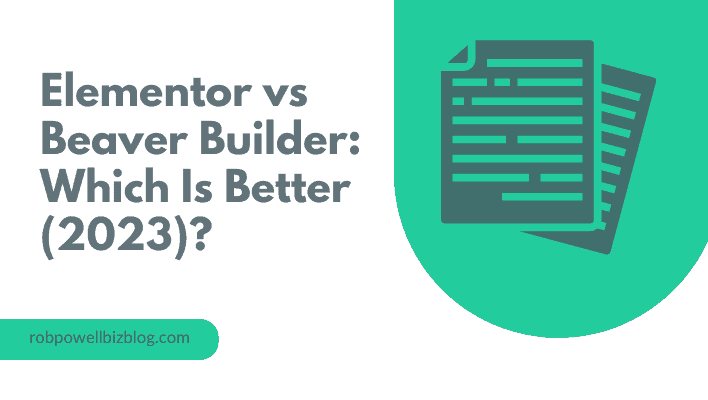
This article contains affiliate links and I will receive a small commission if you make a purchase from this page
The Quick Answer
Both page builders have good user interfaces and both have all the functionality you need to build smart looking websites that deliver great user experience.
Elementor is your best option if:
- you only have one or two websites (Elementor Pro)
- you want a fully functioning page editor without spending a cent (Elementor Free)
- you want a WordPress page builder with more functionality (e.g. a popup builder)
Beaver Builder is your best option if:
- you are a developer and you build websites for clients
- you plan on using the page builder on more than three websites (Beaver Builder can be used on unlimited websites).
- you want a white label option (i.e. an end product that you can sell to your client with no branding).
What Are Page Builders?
But first of all, what are page builders?
A page builder is a WordPress plugin that allows you to build pages on your website by dragging and dropping elements such as columns, rows, headers, text boxes, and widgets.
They often come with a library of predesigned templates, layouts, and design elements.
Page builders make the process of creating a website easier and faster. They allow you to create complex and beautifully designed websites without having any experience with web design or development and without paying a developer to do it for you.
Elementor vs Beaver Builder: Side-By-Side Comparison
Elementor gives you more features and design settings than Beaver Builder. And for many people, that makes Elementor a better option than Beaver Builder.
But Beaver Builder allows you to do a lot more core editing (for example creating layouts or modifying existing layouts). And that makes it a better option for WordPress developers.
Here’s my detailed comparison of these two page builders against seven key criteria:
- Interface
- Design Options
- Responsive Design
- Templates
- Popup Builder
- Theme Builder
- Pricing
#1. Builder Interface
Elementor User Interface (UI)
The interface is a good place to start our comparison because it’s where you’ll be spending a lot of your time.
When you create a new blog post with this page builder, your screen will be divided in two: the main area where you get a live preview of your blog post and a fixed left sidebar containing elements that you can drag and drop into your blog post.
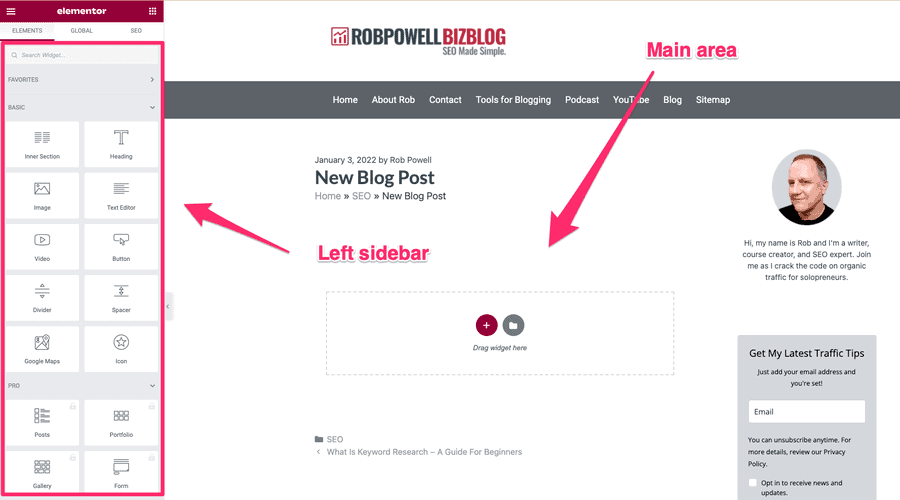
Elementor uses three basic elements:
- Sections
- Columns
- Widgets
Sections are top-level elements: they contain columns and widgets.
Columns are second-level elements: they fit inside sections and they contain widgets.
Widgets are the third level of the building block hierarchy: they are responsible for the actual content on your page. Widgets include things like headers, text, images, video, etc.
Clicking on the plus sign in the main editing area gives you options for adding sections to your blog post.
This is where you create the layout or structure of your blog post. In Elementor, you can choose various combinations of columns and column widths:
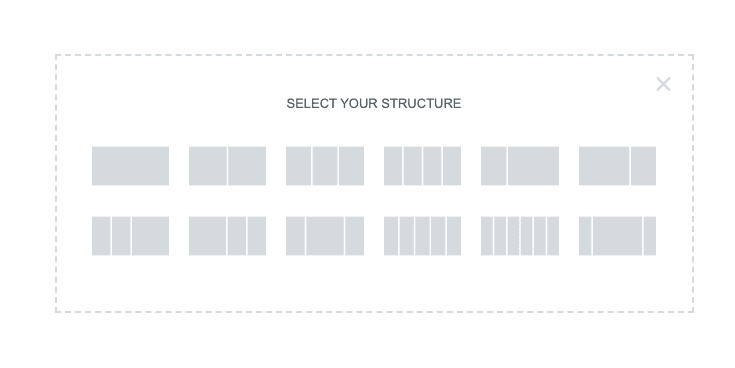
Once you’ve chosen the layout for that section, you then have the option to add elements from the left sidebar:
You can then drag an element, such as a text block, onto your page:
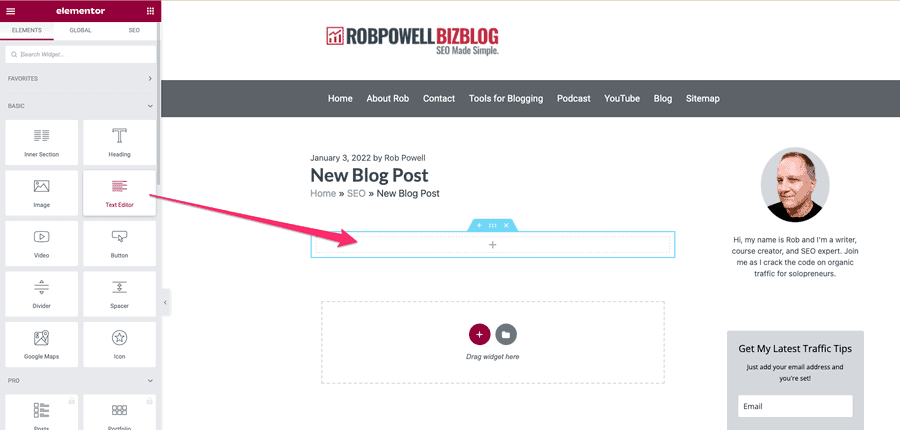
To add another element, such as an image, simply repeat the process.
It’s an easy-to-use interface and feels pretty intuitive.
As you would expect from a leading pager builder, Elementor has inline text editing, meaning that you can type directory into the editing area of your page.
The fixed left sidebar contains all the WordPress widgets that you need to format and create your blog post.
A useful feature in this page builder is the right-click navigation. When you right-click on any element, a drop down pops up offering you various editing options.
This right-click menu gives you the option to quickly duplicate an element or change its styling.
Another useful feature in Elementor is the ‘navigator’. This is a tree panel providing easy access to the design hierarchy.
The navigator allows you to see exactly which design feature you are working on and quickly jump to another feature in your page. In Elementor, the right-click menu also allows you to save an element as a template.
In the bottom left of the interface, there are buttons that give you access to some useful tools: settings, navigator, history, responsive mode, and preview:
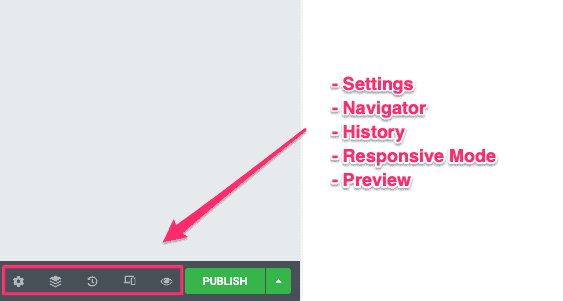
Beaver Builder User Interface (UI)
The Beaver Builder interface works a little differently from Elementor’s.
When you start a new blog post, the entire screen is your preview. In the top right corner is a blue plus sign. Click on that and you get a dropdown menu where you can add modules, rows, and templates:
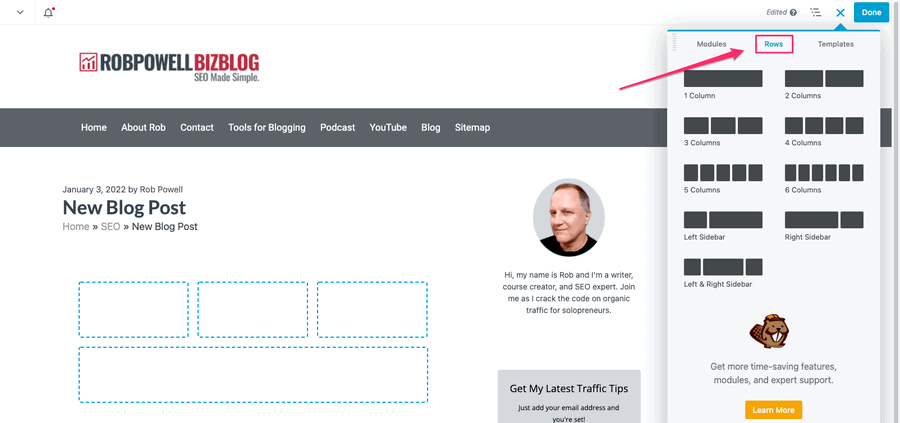
The terminology in these two page builders is slightly different.
What Elementor calls ‘widgets’, Beaver Builder calls ‘modules’.
But they are exactly the same thing. In both editors, they are the building blocks you use to create your web page.
The rows create the layout of your page and the modules create the content of your page.
When you add a module to your page, a popup appears that allows you to control the content and styling of that module. For example, here’s a text module.
You can type your text into the popup or directly into the page itself.
You can drag these module popups around the screen and place them wherever you want. This makes Beaver Builder a lot more flexible than Elementor, which uses a fixed left-side menu.
Beaver Builder’s interface layout is more customizable than Elementor’s. For some people, this makes it easier to use than Elementor.
Rows and columns also have popups that allow you to control their style.
The workflow for building your page in Beaver Builder is:
- Click the plus sign in the top right corner to add either a row or a module
- Use the pop up for that row or module to format the element the way you want it
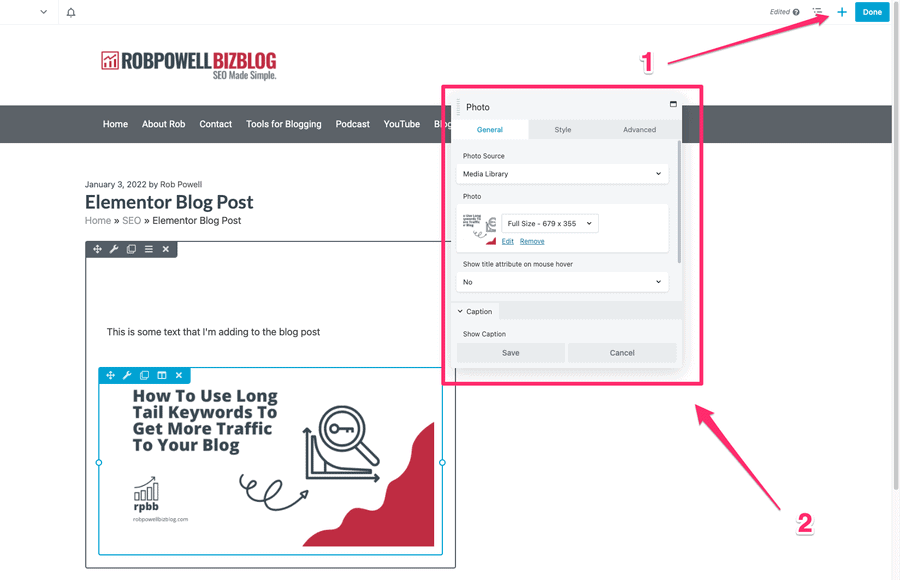
As with Elementor, Beaver Builder gives you a tree panel that shows you the hierarchy of design elements and identifies the element you are currently working on.
User Interface – Which Is Better?
Beaver Builder is easier to use than Elementor – it has a more fluid and flexible interface than Elementor.
With Elementor you have a fixed, left menu. But with Beaver Builder, you have editing popups that you can move around the screen. Some people will find that more user-friendly.
On the other hand, Elementor gives you right-click access to important functions like copy/paste (Beaver Builder doesn’t have this).
Also, Elementor gives you 57 different widgets compared with Beaver Builder’s 37.
So which has the better interface?
It comes down to Beaver Builder’s moveable popup menus versus Elementor’s fixed left menu. Personally, I prefer a fixed menu – Beaver’s movable popups can can get in the way of your workspace.
But in the end, it depends what your personal preference is.
#2. Design Options
What options does each WordPress builder give you for designing your pages? How granular are the controls? Do they give you advanced styling options such as mouse animations and motion effects?
That’s what we’ll look at in this section.
Elementor Design Options
In Elementor, the design of your pages comes down to the widgets or modules that create the content itself. Elementor gives you 57 different widgets divided into ‘basic’ and advanced’:

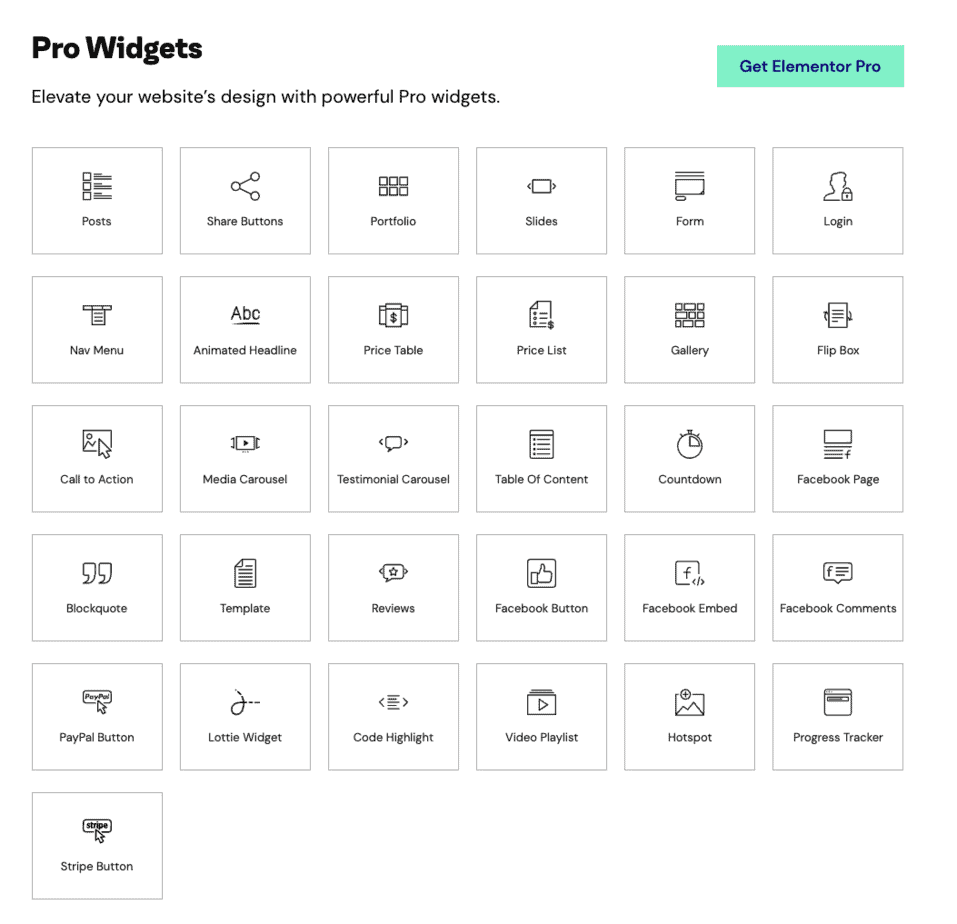
Elementor gives you the ability to control every aspect of your layout and content.
This includes things like column width, margin, padding, font face, color, size, and text-shadow. You also have full control over the background settings.
With Elementor, you get access to even more advanced design features. For example, you can add CSS to individual elements, use absolute or relative positioning, and use sitewide settings that guarantee consistent design across your entire site.
Elementor also offers a powerful toolset for creating scrolling and mouse animations, including advanced motion effects.
These effects include:
- vertical scroll (parallax effect)
- horizontal scroll
- transparency
- blur
- rotate
- scale
- mouse track
- 3D tilt
Beaver Builder Design Options
Beaver Builder gives you 37 different modules (less than the 57+ widgets that Elementor offers):
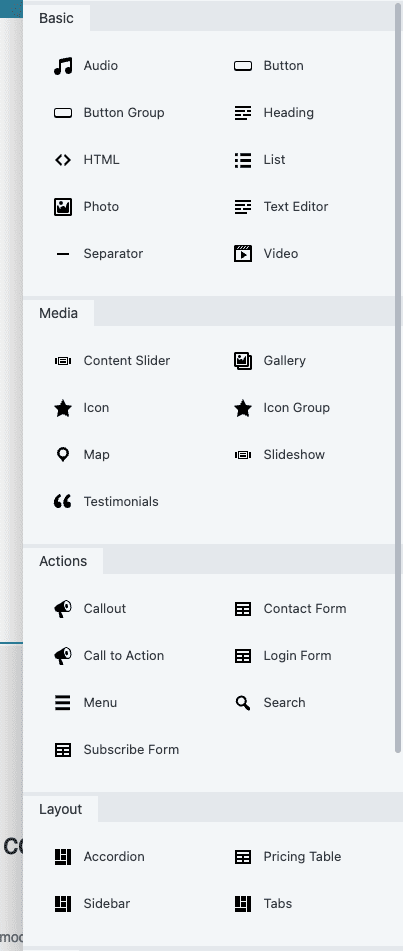
Beaver gives you all the core design features you would expect in a leading page builder. You can apply design settings to rows, columns, and modules.
For rows and columns, you have two design tabs: style and advanced. For modules, you have three design tabs, general, style, and advanced.
Also, Beaver Builder has recently added the ability to apply CSS to individual design elements.
Design Options – Which Is Better?
Elementor offers more features and design controls than Beaver Builder.
For example, motion effects and custom positioning are both available in Elementor but not supported in Beaver Builder. Also, Elementor gives you many more widgets or modules than Beaver does.
One difference between these two page builders is that Beaver Builder inherits your theme’s fonts and colors by default. In Elementor, you have to disable Elementor’s default colors and typography if you want to use your theme’s fonts and colors. On this issue, I prefer Beaver Builder’s approach.
However, in terms of design options, my overall preference is for Elementor.
#3. Responsiveness
Responsiveness makes web pages render well on a variety of devices, including desktop, tablet, and mobile. Its essential if you want your visitors to have a good user experience.
How do these two WordPress page builders compare in terms of responsiveness?
Elementor Responsiveness
Elementor’s designs are automatically device-responsive, but you also have full control over responsive design settings.
At the foot of the panel toolbar are the responsive preview controls. These allow you to switch between desktop, tablet, and mobile previews.
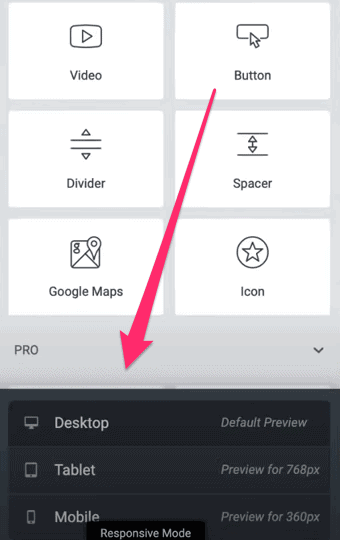
You will see these same options in the settings for any given widget, column, or section.
Some elements just don’t display well on mobile. And that’s why Elementor also gives you the option to hide elements on desktop, tablet, or mobile.
Beaver Builder Responsiveness
All the designs on Beaver Builder are responsive by default. And as with Elementor, you can view your page in different viewports (desktop, tablet, and mobile) and make adjustments that only affect how the page displays on a particular type of device.
In Beaver Builder you can do this for any row, column or module that displays a device icon:
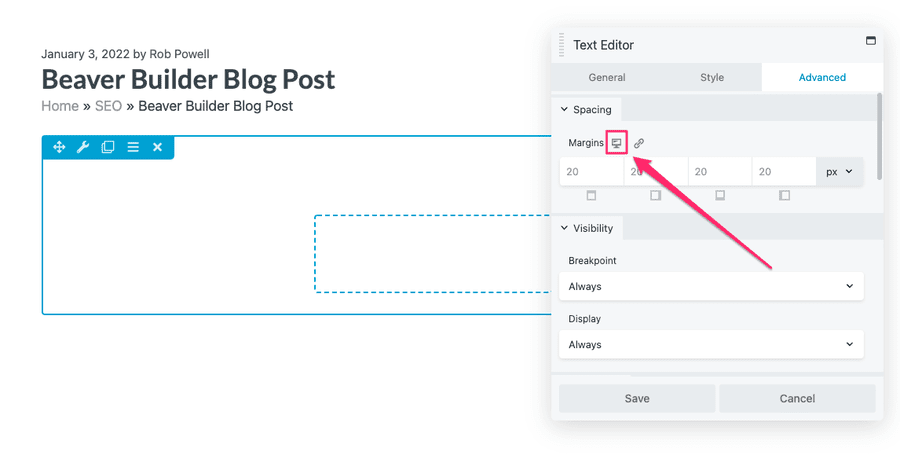
Beaver Builder, like Elementor, lets you define the breakpoints for responsive display.
And as with Elementor, Beaver has a preview mode that allows you to view your page on different device sizes.
Responsiveness – Which Is Better?
These two page builders both allow you to adjust your designs so that they display properly across all devices. On this issue, there’s very little to choose between the two platforms, so this is a draw.
#4. Templates
Templates can save you a ton of time. These may be templates that have been pre-designed for you or they may be your own templates that you create from scratch.
Either way, the ability to drop templates into your web pages is a game changer. It improves your workflow and increases your productivity.
Let’s see which of these two page builders has better templates.
When you start a new post or page in Elementor, the first thing thing you see is an option to use a template.
Elementor comes with two kinds of ready-made templates: blocks and pages. Block templates are professionally designed, ready-to-use widgets that you can drop into a page.
You can customize any block template so it looks the way you want it and then save it to be used over and over again.
This will save you a lot of time.
Page templates are designer-made page layouts. You can search the template library for designs that fit your niche:
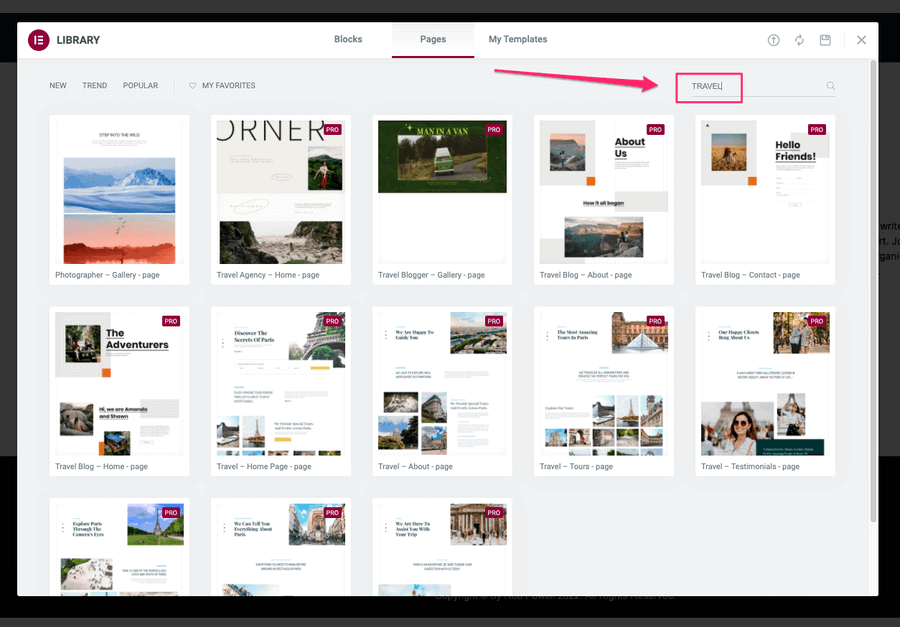
Once you’ve chosen a page layout template, you can customize it and save it as a template that you can use again.
Elementor Pro gives you access to over 40 page templates and over 160 block templates.
Elementor recently introduced another kind of template: WebKits.
These are themed sets of templates that help you build an entire website for a particular industry or niche. Elementor currently offers the following WebKits:
- Beauty & Hair
- Blog
- Business & Services
- Creative
- Ecommerce
- Education
- Events & Entertainment
- Fashion
- Food & Drink
- Health & Wellness
- Music & Bands
- NGO
- Portfolio & CV
- Retail Stores
- Seasonal
- Sports & Fitness
- Technology
- Travel & Tourism
Beaver Builder Templates
Beaver Builder offers two kinds of templates: landing page templates and content page templates (but no widget or module templates).
Landing page templates are professional-looking standalone pages designed to convert:
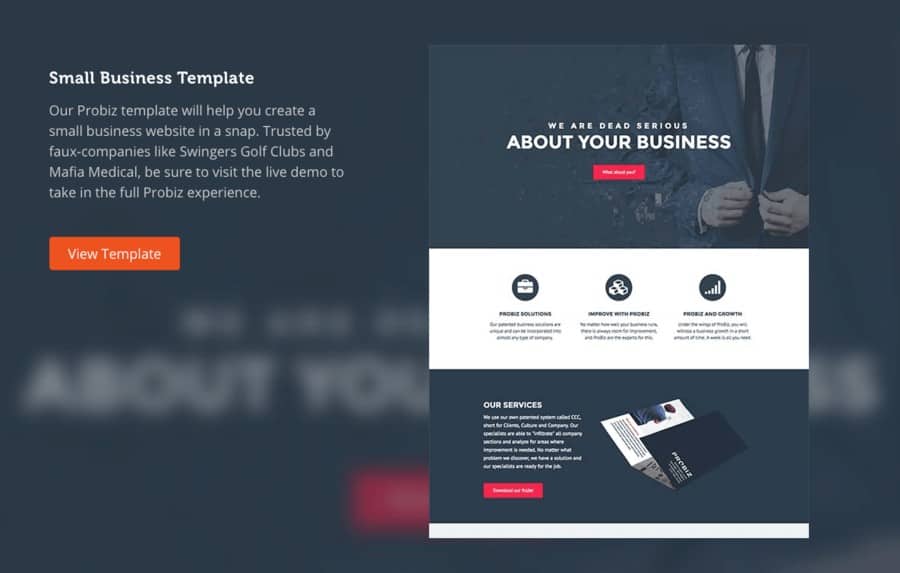
Content templates are regular website pages, such as ‘About’, ‘Contact’, and ‘Portfolio’ pages.
In Beaver Builder (as with Elementor) you can customize these templates and then save them to your template library.
There are 110+ Beaver builder templates (these are ready-to-use page templates).
Templates – Which Is Better?
Both of these WordPress builders have large template libraries.
However, on the issue of templates, my preference goes to Elementor because it offers widget or block templates whereas Beaver Builder doesn’t.
#5. Popup Builder
This is a feature that is only available in Elementor – at time of writing there is no ability to create popups in Beaver Builder.
The Popup Builder is included in Elementor Pro and it uses the same left-side panel that you use to create and edit pages and posts.
There are a variety of different popup templates to choose from, including email opt-in forms, promotional banners, and upsells:
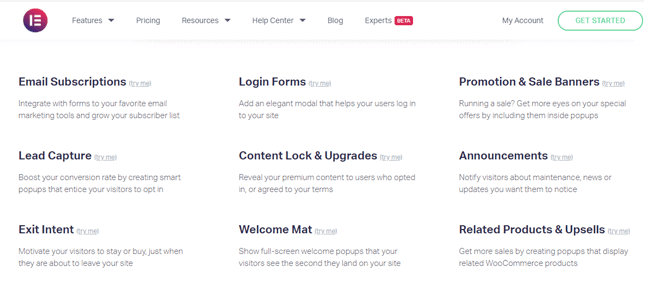
You can use a ready-made popup template or you can build your popup from scratch.
Elementor’s Popup Builder gives you all the advanced settings you need to control the way your popup behaves, where it appears, and when.
#6. Theme Builder
Both page builders give you the ability to design not just individual pages but an entire website.
They do this through a ‘theme builder’ that allows you to create standard elements, like headers, footers, single posts etc. These elements are then used across your website to create a theme that contains your branding.
So which of these two page builders has the better theme builder?
Elementor Theme Builder
Elementor’s Theme Builder lets you design an entire site. It uses the same interface you use to create pages and posts.
The Theme Builder consists of a number of ‘site parts’ such as header, footer, single page, single post, etc.
There are templates for each of these site parts which you can customize:
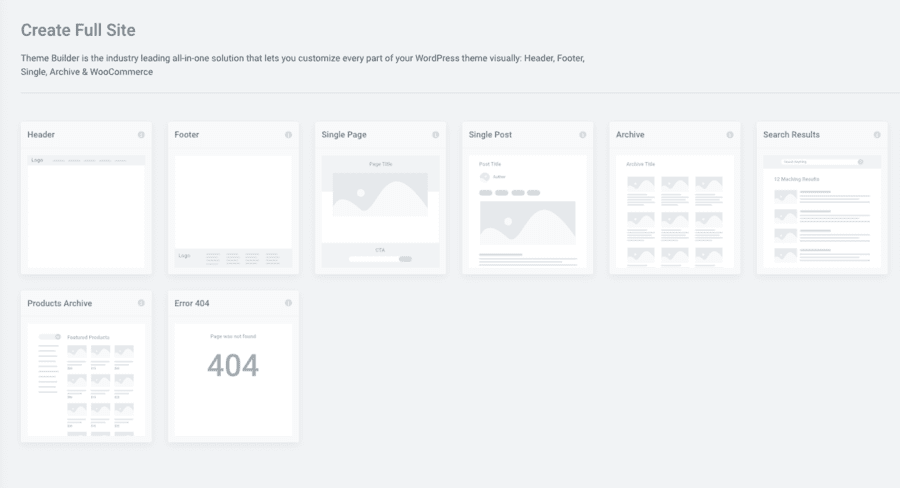
Once you have customized a site, you can control where it appears on your site. For example, you could design a ‘single post’ layout that only appears for posts by a particular author.
Developers will be interested in Elementor’s dynamic tags. These allow you to display content dynamically, using third-party widgets.
Any field that has the dynamic tags icon next to it can be populated with dynamic content.
As well as templates for individual site parts, Elementor also offers templates for entire website designs. These are called ‘website kits’ and there are over 60 of them included in Elementor Pro.
Elementor’s Theme Builder works with any WordPress theme – so no need to worry about compatibility.
Beaver Builder Theme Builder
Beaver Builder also has a theme builder, called Beaver Themer. However, Beaver Themer is not part of the page builder and must be purchased separately.
Beaver Themer uses the same interface that you use in Beaver Builder to create individual pages and posts:
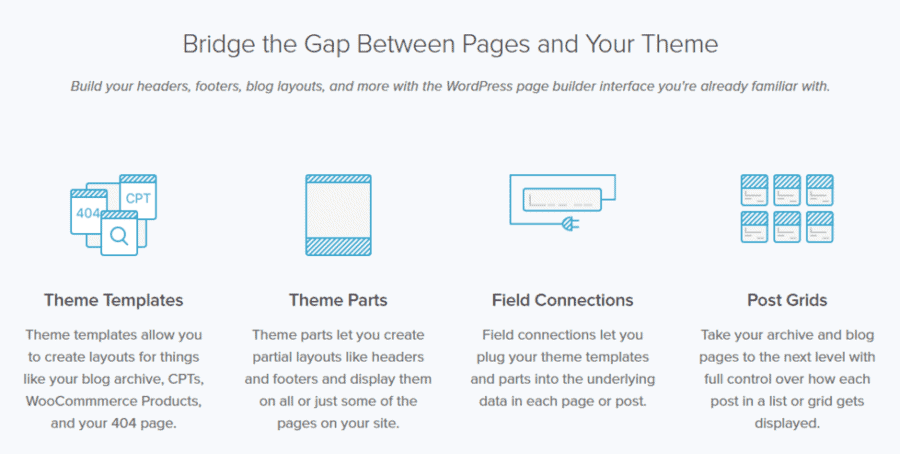
You can use Beaver Themer to design any sitewide element, including the header, footer, archive, single post, 404 pages, and so on.
Beaver Themer uses WordPress hooks to inject content at specified places across your website.
Beaver Themer’s rules-based customization gives you considerable power and flexibility in the way you customize your website. It uses conditional logic to fine-tune exactly where and when Themer layouts or parts of Beaver Builder layouts are displayed.
Theme Builder – Which Is Better?
The theme builders in Elementor and Beaver do much the same thing: they allow you to create site-wide templates that give your website consistent branding, appearance, and layout.
Both builders allow you to customize your entire website using your own templates. They both offer powerful rules-based options for determining where templates will appear across your site.
The main difference between the two theme builders is not in what they do but in the pricing.
Elementor’s Theme Builder is included with Elementor Pro. Beaver Themer, on the other hand, is not included in Beaver Builder Pro: it’s an add-on that costs an extra $147.
In my view Elementor is the clear winner here, simply because their theme builder is included in the Pro version of their page builder.
#7. Pricing
There are some important differences in the pricing between Elementor and Beaver Builder. And you’ll need to take into account these differences when choosing between these two page builders.
Elementor Pricing
Elementor has three tiers in its pricing:
- Essential: $49 p/year (1 site)
- Expert: $199 p/year (25 sites)
- Agency: $399 p/year (1000 sites)
Elementor recently began offering WordPress hosting. There are four tiers of hosting and they all include Elementor Pro:
- Basic: $9.99 p/month
- Business: $19.99 p/month
- Grow: $22.99 p/month
- Scale: $49.99 p/month
Beaver Builder Pricing
Beaver Builder has four tiers in its pricing:
- Standard: $99 p/year
- Pro: $199 p/year
- Agency: $399 p/year
- Ultimate: $546 p/year
Beaver Builder allows you to use the plugin on unlimited websites in all their plans. And all plans renew yearly with a 40% discount.
Pricing – Which Is Better?
A big difference between these two page builders is that the number of sites you can install Elementor on depends on the plan that you choose. With the basic plan (Essential) you can install it on only one site.
Beaver Builder, on the other hand, allows you to use the plugin on unlimited websites in all their plans.
If you have just one website, then Elementor has the better pricing. If you have two sites, its a draw between Elementor and Beaver.
But if you have more than 3 websites, Beaver Builder is more economical than Elementor. For example, it would cost you only $199 to install Beaver on 1000 websites, but it would cost you $399 to do the same thing with Elementor.
Beaver Builder Pros and Cons
Beaver Builder Pros
- Fast, stable, and glitch-free
- You can drag the interface windows around, which makes for more streamlined workflow
- You can use Beaver Builder on unlimited sites on all plans – great value if you plan to use it on lots of sites
- All plans renew with a 40% discount
- More lightweight than Elementor
- Easy to use – almost no learning curve
- Excellent customer support
- Content widgets are accessible without scrolling
- You can use WordPress widgets inside Beaver Builder’s content blocks
Beaver Builder Cons
- More expensive if you’re only going to use it on one site
- Limited templates compared with Elementor Pro
- Fewer advanced design settings than Elementor Pro (no motion effects, custom positioning, or global design system)
- No right-click functionality in the interface
- No popup builder
- No form builder
- Theme builder costs extra (it’s included with Elementor Pro)
- Beaver Theme does not allow you to create headers and footers (only controls the content area)
Elementor Pros and Cons
Elementor Pros
- Much cheaper than Beaver if you only need a builder for a single site
- Gives you a theme builder in the core plugin, whereas Beaver Builder makes you purchase a separate product
- It’s the most popular page builder and that means there are lots of third-party add-on plugins
- Right-click makes copy/paste for elements or styles much more streamlined
- More design settings than Beaver, including motion effects, custom positioning, etc
- Includes a popup builder
- The core product is 100% free
- Lots of content widgets and templates
- Includes shape dividers (graphic shapes that separate the sections of a page)
- Much bigger template library than Beaver, plus entire website templates (called website kits)
Elementor Cons
- The user interface is not as customizable as Beaver Builder
- More expensive if you plan to use it on 3 websites or more
- Interface is not as fast as Beaver’s
- Content widget panel requires you to scroll up and down to find the content you want
- In the past there have been bugs with new updates
- Steeper learning curve (because it has more features and options than Beaver Builder)
- Elementor can slow your site down more than Beaver
- Support is not as good as Beaver Builder
- No white label version (the Agency version of Beaver allows you to white label)
Which Is Right For You – Elementor or Beaver Builder?
Choosing between Elementor and Beaver Builder is not easy as they are both excellent drag-and-drop page builders.
But in the end, you do have to make a choice. So here is a summary of the pros and cons of each page builder.
Styling and responsive design
If you want as many advanced styling and responsive design controls as possible, then Elementor is the best choice: Elementor offers more features and design options than Beaver.
Elementor also gives you many more stylistic options than Beaver Builder.
Content blocks
Elementor gives you more content blocks and more templates than Beaver. Another nice thing about Elementor is that whichever plan you choose (Essential, Expert, or Agency) you get all the features. They don’t limit the features according to which plan you sign up for.
Free plan
If you are on a tight budget, then Elementor is the obvious choice because the free version of Elementor has far more features than the free version of Beaver Builder.
Intuitive interface
Beaver Builder has a more fluid and flexible interface than Elementor. The editing pop-ups that you can move around the screen make it easier (and faster) to use than Elementor.
But Beaver doesn’t have as many features as Elementor. In Beaver, the side panel loads the entire editing menu on one screen, and that makes easier to work with. In Elementor, you have to scroll down to see all the editing options.
Multiple websites
The choice between these two page builders becomes easier once you have more than two websites.
Using Beaver Builder on unlimited sites costs $99 a year, which is the price of using Elementor on just two sites. If you need a page builder for more than two sites, Beaver Builder is the better choice. And that’s why Beaver is popular amongst developers.
Another reason why developers prefer Beaver Builder is the ‘white labelling’ options in the Agency version. In the Agency plan you can remove the Beaver Builder branding from the software.
Elementor Pro and Beaver Builder are similarly priced up to two websites. But once you go beyond two websites, Beaver Builder becomes significantly cheaper.
Also, Beaver Builder renews with a 40% discount that continues year on year. With Elementor, you’ll be paying the same price to renew every year.
Conclusion
Hopefully this comparison of Elementor vs Beaver Builder has helped you decide which of these two WordPress page builders is right for you. If not, here are some final thoughts that may help you choose.
If you are a small business owner with two websites or less, your best choice is Elementor. You get a feature-rich builder with a lot more styling and design controls for half the price of Beaver Builder.
But if you need a page builder for more than two websites, then Beaver is your best option because all three tiers can be used on unlimited sites.
Basically, it comes down to this: Elementor gives you more features and design settings but Beaver Builder lets you use their page builder on more sites.
If you still can’t decide, why not try them out? They both have free versions. You can download the free version of Beaver Builder from the WordPress repository. And the free version of Elementor is available here.
But whichever you choose, you can’t go too far wrong because these are the two best page builder plugins for WordPress.